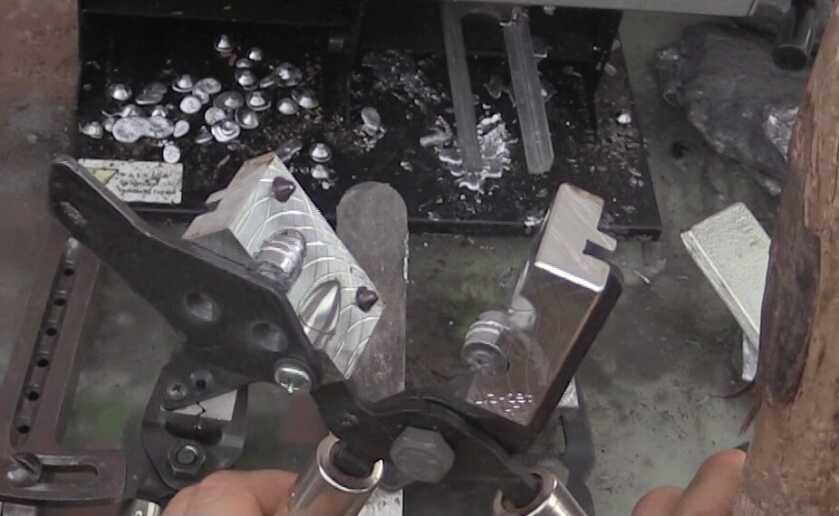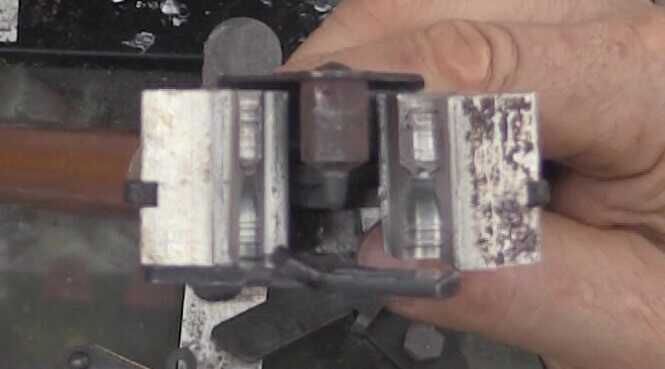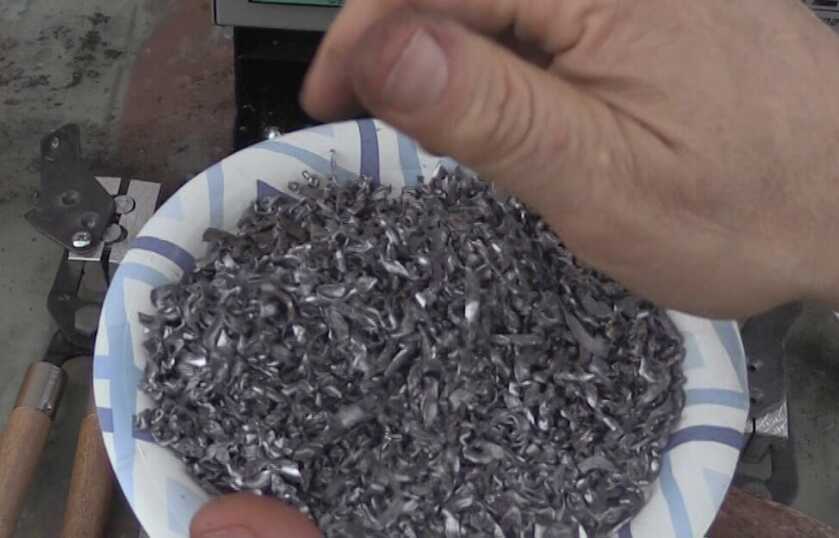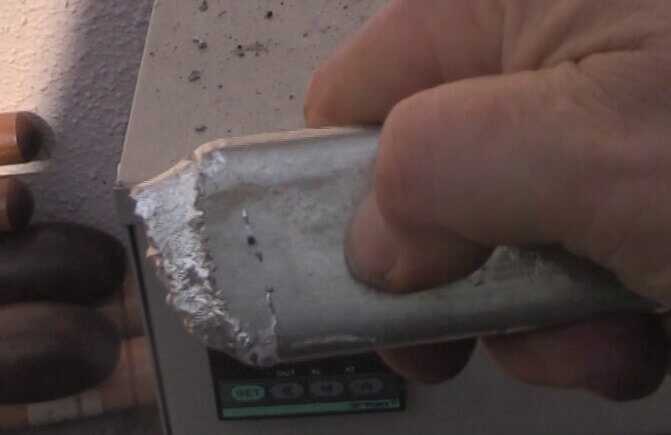
At some point you have to admit to yourself that we may not ever return to “normal,” and that is about where I am right now. So if you want to be able to shoot at a reasonable price, at least in the forseeable future, it might behoove you to learn how to cast bullets, and get the rudimentary stuff to do it. This is going to be another basic how-to in my new series on black powder pistols.
Casting bullets is one of those very deep subjects full of mixed information and disinformation all over the interwebs, most of which is written by people who have never melted lead. That is why I am doing videos as I go, so you can see what’s going on.
I will, however, distinguish between casting bullets for long range shooting or competition and casting simple pistol bullets for plinking, which is my focus here. I personally own several printed volumes of information on the former topic. Subjects range from types of molds, to things you wouldn’t think of, like types of sprue plates, how tight you run the sprue plate, how many cavity mold is good for consistency, alloy types, lube, all kinds of crazy stuff.
The latter is stupid easy. You can’t mess it up.

First off, you need a pot. Now as I explained in the video, I have never just melted lead in a cast iron pot on the stove, or on a gas burner. It works. You can find RCBS and Lyman cast iron pots out there that are made small and deep for casting. Or just a regular Walmart Lodge pot will work if you have enough lead to fill it.
I have always used a 110v electric furnace from either Lee or Lyman. You will also find 220v out there, but I have never seen a need to run a second leg when the cord never even gets hot, and the lead melts quick enough and maintains temperature easily.
Right now the pot I use in the video is available from Midsouth Shooter Supply for $367. It is a bottom pour pot. As you can see, the handle just happened to break on it as I was shooting this video. I looked and it was January 14th that I bought this one, and when I added it up in my head, I have probably made just north of 10,000 bullets with it since then. I am hoping Lyman will send me a replacement.
In this case, I don’t think I did anything to specifically break the handle. But it is a good example of why I do not favor bottom pour pots. When they work, they work great, but eventually things go wrong with them. The hole gets some crap in it sometimes, and the pot just runs and runs until it is empty. I have also had it just stop working because crap got in there, and you have to empty the pot and work whatever is in there out with a pin or something.
So from a rate of casting perspective, the bottom pour pot is for sure better, but you end up losing time curing the problems with it. I’ve never had the handle break like this before, and I have had a similar Lyman with just a dial adjustment for a decade or more, no problem. This was an oddball problem. But bottom pour pots are not without their issues anyway.
Finding Molds
Right now it isn’t a matter of the best case scenario. Right now it is what is the lowest common denominator that I can actually do with available resources.
The best molds for black powder pistols are of course those from Eras Gone Bullet Molds. I was fortunate to have found them before this craziness had hit full stride, so I have them and can use them. At present the next delivery is due in late June, but that date has already been pushed a few times.

What makes the Eras Gone bullets special is that they are duplicates of actual Civil War period bullets, and they have a lower diameter “skirt” at the bottom of the bullet. This perfectly centers them in the chamber as you press them in with the loading lever, and it shaves them so there is no wobble as they launch toward the forcing cone of the revolver.
In the video I show you what I think is honestly your best bet right now. Roundballs. Because as crazy as things are right now, to the point where you can’t hardly buy roundballs, the molds for them are still out there, and you can sometimes score a decent buy. Believe it or not, I bought that 4 cavity roundball mold you see in the video on Ebay only about three months ago, and I got six four cavity molds total for like $245. Nobody else wanted them because they were beat up, but I could see that they still would work fine, and they all do.
Aluminum molds are mostly what you will find out there. Lee makes a 1 and 2 cavity, and there are any number of roundball molds from Lyman, RCBS, Ideal, and many other old names out there every day online. You are going to pay more, but that’s just where America is going right now. You don’t put 4 trillion extra dollars on the street to compete for the same amount of goods and services without those goods and services going way up in price. Most of that money was given away for free.
I will also share with you a resource that I can’t personally recommend, but that has a good reputation. It is Accurate Molds. They have several designs in the 45 caliber range that will fit a 44 black powder revolver, and several 37-38 caliber designs that specifically say percussion or cap n ball revolver. Right now they are about 10 weeks out the website says, and I put an order in mid April, so we’ll see. A 5 cavity mold is $146.

Other than that, just troll Ebay. I wish I could say people sell stuff on GunsAmerica like that, but they stupidly don’t. They sell it on Ebay for less than they would get here, and they pay a ridiculous fee. In the video I show you a .375 bullet mold I scored for my 36s, and an old Lee hollowpoint .450 design that fits the chambers quite well.
I have tested currently available for ~$60 Lee .450-200, and it also fits in the chambers of black powder revolvers just fine. With a paper cartridge, it is actually nice and tight. One of my near term projects is to shoot those head to head against the Johnson & Dow bullet. I suspect they won’t be as accurate, because they don’t shave. But the bullets do not go readily into the bore from the front of the gun, so that means they will hit the forcing cone and swage into the grooves of the rifling just fine.
So who knows.

Part of what makes black powder fun is that there are so many variables that interplay and that will give you different performance. The same is true of handloading with cartridges, but go try to find primers these days. I just got a percussion cap order fullfilled from one of my backorders (at powderinc.com which was in a prior article), so yes, you can get caps if you make an effort.
Brass Molds
I don’t know anyone besides me who would tell you to actually go and cast with the brass molds that are replicas of the ones that used to come with the original 1860s pistols. But they do work fine. Pedersoli makes them for the most part, and Pedersoli is a real gun company, not a display or movie prop company. They make molds that work, and make the correct size bullets and balls for Italian percussion pistols.
As you can see in the video, you need to use welders gloves when you cast with these molds. You could also fashion your own wood handles. I also show you in the video my original Colt gang mold that was shipped with the 1860 Army contracts, and that did have wooden handles.

Finding Lead
Don’t believe anyone on the interweb forums who tells you that lead is not available. There are dozens of active lead mines in the US, many refiners, and tons of surplus lead at scrap yards that you can buy for about spot, which is around $1 a pound right now. Just keep trying until you find someone.
For the most part you want pure lead, or as pure as you can get. That said, there is almost no such thing as pure lead in the scrap market, so just ask the seller if they can scratch it with their fingernail. If so, it’s probably fine. In general, all black powder arms are best off with straight lead, because if the bullet is too hard, when it hits the forcing cone it can build excessive pressure, which can damage the gun. In true muzzleloaders you of course have to swage the bullet into the grooves by hand, so the softer the better.
I found the lead you see in the video on a local Facebook for sale board. He was primarily selling large sheets, but had cut some up with a chainsaw and was selling smaller pieces and the chain saw grindings for $1.25 a pound.

You will see in the video that I add a little bit of tin to my lead once it is in the pot. I find that it does not effect the hardness at all, and the tin makes the lead fill out the mold much better without wrinkles. Lead has a high surface tension, so especially the grease groove bands on a muzzleloader bullet can get wanky, and forget about the skirts on Minnie balls (for Civil War rifles). They are so thin that even with the lead at 840 degrees and the mold hot, they will often not fill out. The Eras Gone Richmond Lab 36 also tends to get wrinkly with no tin in the mix.
How much tin? Very little. As you can see in the video, I just dip a bar in about an inch and let it melt off. Then I mix in a bit of beeswax or BP lube as a flux. That helps the metals mix together, or in some cases the metals form an alloy. I don’t remember if it is lead and tin or lead and antimony that do not actually alloy. I don’t ever use antimony unless I am casting magnum bullets.

What I didn’t get into in the video is how far I stretch that tin. Honestly, I can make several thousand bullets before I ever add more tin, and I have never needed to add it where the bullets all of a sudden wrinkle. I usually let the pot get down halfway, add lead back to full, then start again. Then back to half way, then add all the sprue pieces, then do that cycle several more times. At some point I let the pot get down to almost empty, and when I start back up again I’ll put a little more tin.
How much lead do you need? Well there are 7,000 grains per pound. So if you are casting say a 220 grain bullet, that is ~32 bullets per pound.
Speed Casting
I’m trying to share with you guys my experience that will get you going and save you some headaches, so I am going to suggest that you try to get two molds. If you only casting for one gun, two the same is fine. But if you have two guns, just a mold for each, and cast at the same time. Alternate.
This saves you time waiting for the sprue to harden, and it will give you more consistent bullets. If the sprue is too soft, it tears a piece of the bullet away, and it can drag lead across the top of your mold, potentially ruining it. When you have two molds going at the same time, you put them down in between, and while you are doing the other mold the first one hardens sufficiently.
When you are running one mold, you have to stare at the sprue and wait, even though it looks hard enough. It almost never is, and most people end up having a bad experience with a wrecked mold. Aluminum molds actually last forever if you have discipline with cutting the sprue. The best way to do that is run two molds.
You will also be spared the problem of frosted bullets. This is a sign that the mold is too hot, and that the heat could damage it. Run two molds and things will go much more smoothly, with catastrophic failures for the most part mitigated.
Safety With Molten Lead
You guys know that I am far from a safety nanny, but I do have to warn you that molten lead is not to be trifled with. Keep water far away from your pot, because it can seriously blow that stuff all over you.
The biggest danger is if/when you add lead to the pot. If you are using for instance the shattered bullets from an indoor range (the copper floats to the top and you skim it off), perhaps some water got into the bucket, and that water gets dumped in with the metal.
Some of that water will sizzle off on top. But some of it will be dragged down with the metal. And then it turns to steam, and pow, molten lead will really ruin your day.

So just be careful. And don’t be intimidated by the potential for error. We are talking about an unlimited cheap ($1.25 for 32 bullets, and balls are double as many) supply of bullets for your cap n ball pistols. This is seriously really hard to screw up.

Way off topic but the story resurrected a childhood memory of melting lead. Both my uncles on my mom’s side were plumbers of the era when lead pipe was used in water system (FYI lead pipe is safe if the water supply is naturally or made to be slightly basic). I used to watch them melt lead bars over a plumbers furnace (powered by white gas) in a cast iron pot. This was done to seal typically a brass faucet to one end of the lead pipe. The amazing part was watching them ladle out the lead and pour molten lead on the interface point and using a damp canvas pad to catch and shape the lead around the joint. So be safe making your bullets but know you can work lead safely if you follow the rules.
Thank you for the advice on removing the wedge, I just ordered a wedge tapping tool from the website you suggested. I can see where it should make a big difference in removing the wedge
The cleaning article and video should be out for Monday’s digest. If you feel like shooting this weekend, check late friday might be in there.
Very interesting article. Not sure I’m ready to make my own yet but I enjoyed reading about it.
Are you by any chance going to write an article on how to properly take apart and clean black powder revolvers? I’m new to all of this and am having trouble getting the wedge to tap through to take my pistol apart. Online videos make it look so easy but maybe it’s different for a revolver that’s not broken in. Mine has not even been fired yet, still waiting for all the loading materials to arrive. Can’t wait to get started!
The most important thing is to use gunsmithing screwdrivers on the wedge screw. Otherwise you will booger it. When you loosen the wedge screw it will help remove the wedge, but if it doesn’t come out you need a wedge tapping tool, ideally made out of brass. The cartridgekits.com website actually sells them.
A good source for tin is plumbing solder (95%tin, 5% antimony) which is sold everywhere. I think I paid about $18 for a one pound roll at Menard’s.
That’s fine for cartridge bullets. But for cap and ball you want as pure lead as you can get.
~1% tin should be fine but any harder and pressing them into the cylinders becomes a problem.
Great articles re lost art..Black Powder!!
Have used Lee furnace and molds, .44 round balls and .54 for decades. Highly recommended; reminds me of Herters of yore vs. “high end” sellers… Lee stuff continues to be great.
BTW, early pioneers in my family tree didn’t have (or have to add) a bunch of metals…they used LEAD.
BTW: got a trove of Pb by melting down “lead pipes” that serviced Gt. Falls, MT residents fo decades…great for bod…but that’s another story…
Good luck..keep H2O in any form away from your furnace…wear glasses..and gloves…and enjoy!!!
Ditto on being careful while working with molten lead.
I almost had a bad day once when I dropped a little too much wax in to flux the junk out of a small lead pot. It popped under the surface and sprayed molten lead across the floor.
I had fortunately been wearing work boots and heavy jeans along with a gauntlet glove, so I was fine. I just had to spend a while peeling lead spray off the concrete.
Or, it might behoove all of us to put our government in check and let it know in no uncertain terms who the boss is. And that the right of the people to keep and bear arms is the sovereign right of We The People and shall not be infringed. That makes a whole lot more sense in the big picture. But just go on with your bad self casting bullets. It won’t be long before the will of this out of control government puts it’s thumb down on you, just like home gun builders. Fix the disease, not the symptom.
Might want to advise readers on special storage requirements for molds. I also find mercury as best way to remove lead smears from molds. Also works for removing lead from bores. Old plumbing shops can also be source for lead.
What about old car tire weights? Too hard? I’ve seen some old ones that are pretty much pure lead, probably hard to find now. They are a darker grey than the newer ones, which are more of a silver than grey. I suspect the newer ones have more tin in them, as they are generally harder to bend than the old dark grey weights.
They are harder, and most of them are now zinc, not lead. They sure aren’t tin lol. You’d have people stealing them. They steal copper pipe when it was $2 a pound. Tin is 20.